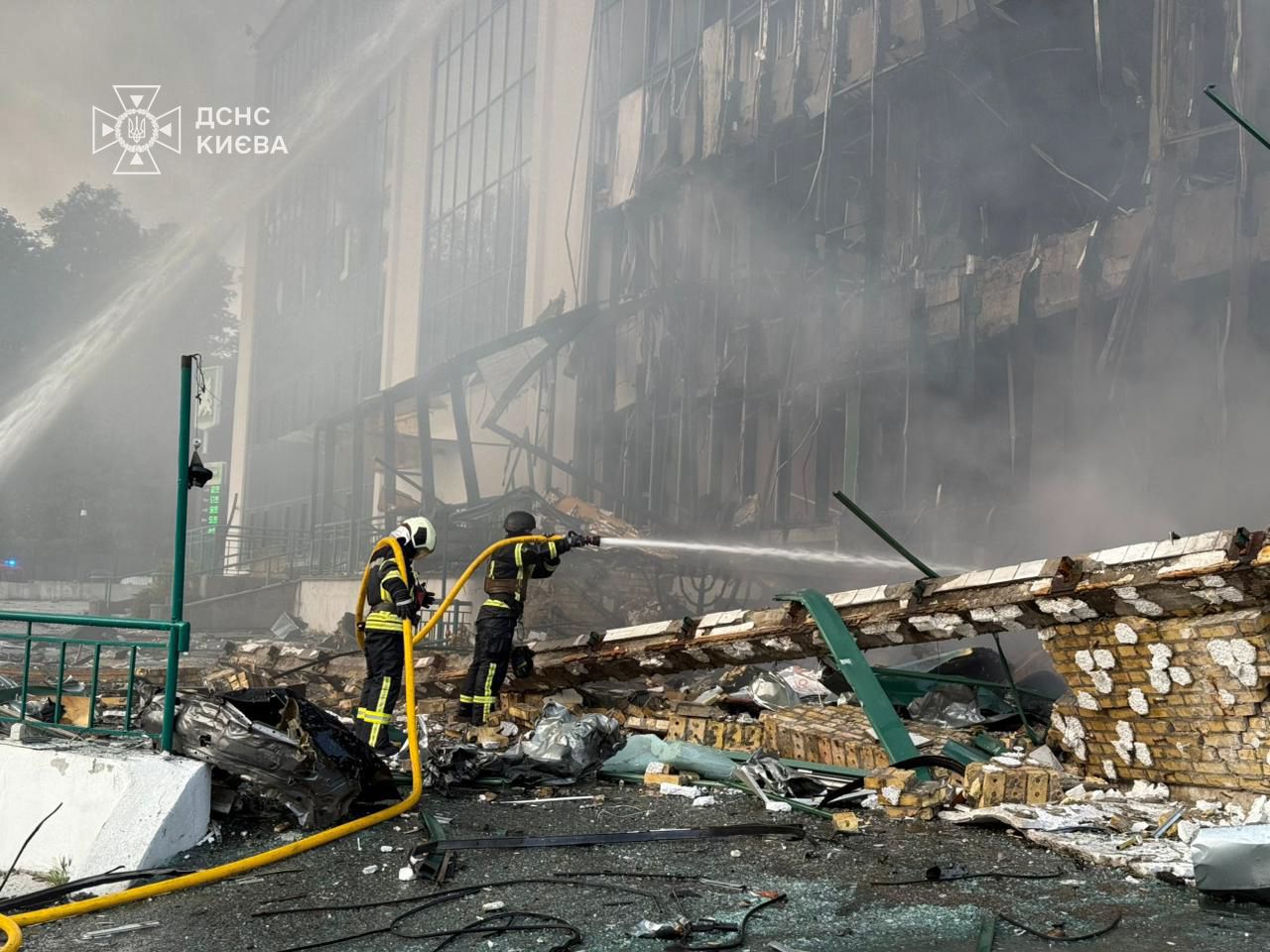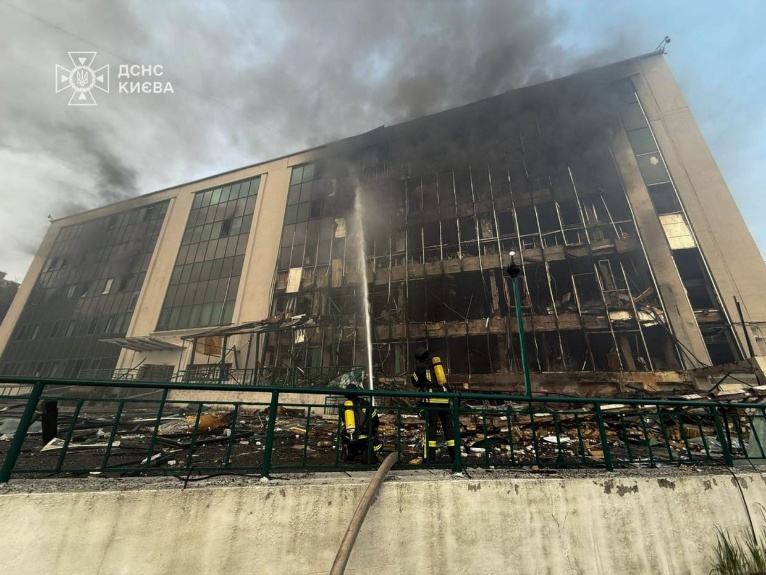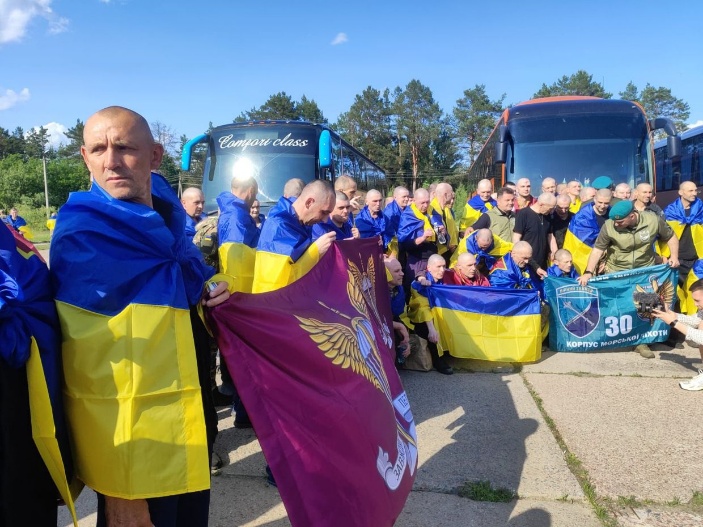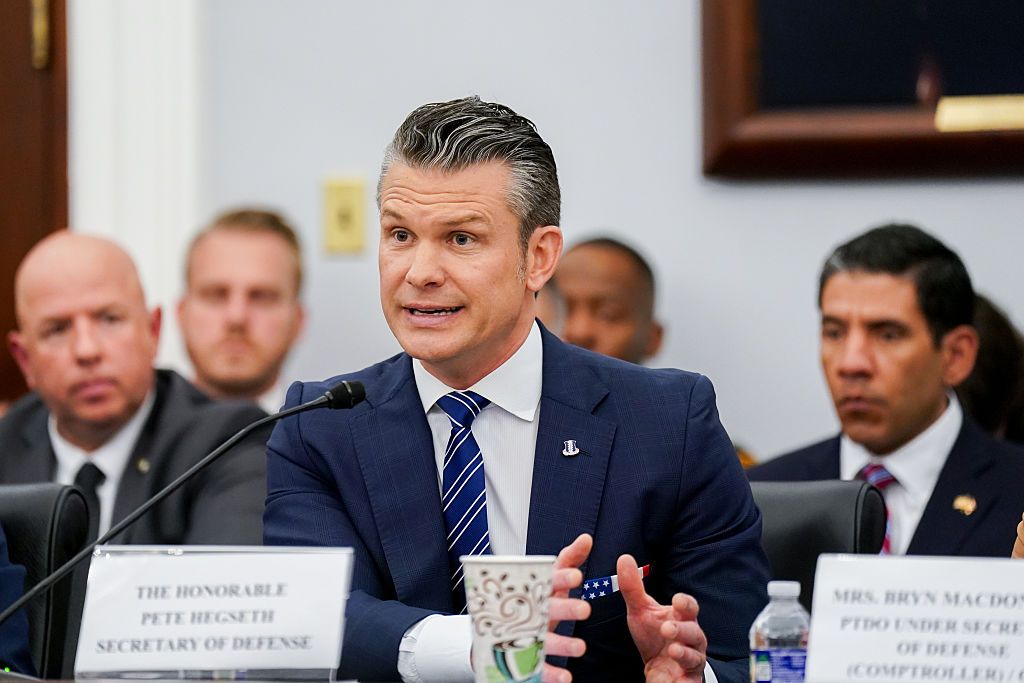As Russia Launches One of War’s Largest Attacks on Kyiv While Exchanging Prisoners Under Istanbul Deal, Putin Recalibrates Nationalist Rhetoric and Europe Unveils Harshest Sanctions Yet
Summary of the Day – June 10, 2025
The contradiction between Moscow’s diplomatic gestures and military actions reached a crescendo as Russia launched 315 drones and ballistic missiles on Ukrainian cities while simultaneously exchanging prisoners under Istanbul accords. The assault—one of the largest on Kyiv since invasion began—killed three civilians and damaged St. Sophia Cathedral. Putin recalibrated from ethnic nationalism to multiethnic unity while intensifying youth militarization. The EU unveiled its harshest sanctions targeting Russian oil and banking, as intelligence revealed deepening Moscow-Pyongyang cooperation in missile technology and drone production.

A woman walks near the damaged St. Sophia’s Cathedral in Kyiv following Russian drone strike on the capital. St. Sophia’s Cathedral dates from the 11th century and is a UNESCO World Heritage Site. (Tetiana Dzhafarova / AFP via Getty Images)
The Cathedral Under Fire: 315 Drones Against Ukraine’s Soul
The night sky over Kyiv erupted at 3 a.m. as Russia unleashed 315 Shahed-type attack drones and decoys, two North Korean KN-23 ballistic missiles, and five Iskander-K cruise missiles in a coordinated barrage lasting over five hours. The assault struck with methodical precision across the capital’s districts, leaving death, destruction, and flames in its wake.

Firefighters extinguish a fire in the aftermath of a mass Russian missile and drone attack in Kyiv, Ukraine, overnight. (President Volodymyr Zelensky / Telegram)
Ukrainian air defenses intercepted all seven missiles and shot down 213 attack drones. The remainder found their targets. In the Obolonskyi district, a woman died when drone debris crashed near a residential building. Four others were hospitalized as fires consumed high-rise buildings, warehouses, and vehicles across multiple districts.

Firefighters extinguish a fire in the aftermath of a mass Russian missile and drone attack in Kyiv, Ukraine, overnight. (President Volodymyr Zelensky / Telegram)
The attack reached Ukraine’s spiritual heart. Blast waves damaged the cornice of St. Sophia Cathedral’s central apse—the 11th-century UNESCO World Heritage site that stands as one of Ukraine’s most sacred landmarks. “Tonight, Russia struck again at the very heart of our identity,” Culture Minister Mykola Tochytskyi wrote. The cathedral, which survived Mongol invasions and Stalin’s purges, now bears scars from Putin’s war.
The destruction extended to Odesa, where two men died and eight civilians were wounded. Russian drones targeted a maternity hospital housing 85 adults and 22 children. All had sheltered in time, but the message was clear: no place, no matter how sacred or vulnerable, remains safe.
Return from Hell: The Second Wave of Broken Bodies
Even as Russian missiles fell, the humanitarian machinery of the Istanbul agreements continued to function. Ukraine and Russia conducted their second prisoner exchange under the framework established during June 2 negotiations, with Ukrainian defenders returning home bearing the physical and psychological wounds of Russian captivity.

A picture of the latest POW exchange between Ukraine and Russia. (President Volodymyr Zelensky/X)
The returnees included personnel from Ukraine’s Navy, Ground Forces, National Guard, and other services. Many were defenders of Mariupol who had endured more than three years in Russian prisons. All bore testimony to their treatment: amputated limbs, vision problems, abscesses, infections, shrapnel wounds, chronic diseases. Some carried hepatitis and tuberculosis.
“Today marks the first stage of the return of our injured and severely wounded warriors from Russian captivity,” Zelensky wrote. “All of them require immediate medical attention.”
The Russian Defense Ministry confirmed receiving a corresponding group of Russian prisoners, transported to Belarus. The exchange represented the second phase of the only tangible progress from Istanbul talks that otherwise foundered on Russia’s maximalist demands for Ukrainian territorial surrender.
Putin’s Rhetorical Pivot: From Ethnic Fire to Multiethnic Unity
In a Security Council meeting focused on “unification of the peoples of Russia,” Putin appeared to step back from recent ethnic nationalist rhetoric, instead emphasizing Russia’s multiethnic and multireligious character. The shift revealed internal calculations about maintaining social cohesion while prosecuting an increasingly unpopular war.
Putin highlighted military-patriotic youth programs designed to forge the next generation of Russian warriors. The “Movement of the First” and “Yunarmiya” (The Youth Army) received presidential praise for instilling pro-war sentiments in children and teenagers. He also promoted state-mandated weekly school lessons featuring soldiers from the Ukraine front.
The president’s remarks indicated unwavering commitment to anti-Western sentiment and military preparation. Putin platformed BRICS, the Collective Security Treaty Organization, and the Commonwealth of Independent States as foundations of his envisioned anti-Western Eurasian security architecture.
His emphasis on “unity of the peoples of Russia” suggested recognition that ethnic Russian nationalism risks fragmenting the country’s multiethnic population. Putin must balance appeasing influential ultranationalist constituencies with the need to maintain internal stability and leverage migrants for economic and military purposes.
The Pyongyang Pipeline: Drones, Missiles, and Migrant Warriors
Ukrainian intelligence exposed the deepening scope of Russian-North Korean military cooperation, revealing agreements that could reshape regional security far beyond the Ukraine conflict. Lieutenant General Kyrylo Budanov disclosed that Russian Security Council Secretary Sergei Shoigu had agreed to increase North Korean labor migration to Russia—a direct violation of UN Security Council Resolution 2397.
More ominously, Russia agreed to help North Korea establish domestic production of Shahed-type kamikaze drones. The technology transfer represents a quantum leap in Pyongyang’s military capabilities, potentially enabling strikes across the entire Korean Peninsula and overwhelming South Korean air defenses.
Budanov revealed that Russia had dramatically improved North Korea’s initially defective KN-23 ballistic missiles. The weapons, which initially flew with deviations of several kilometers and frequently exploded mid-air, now strike targets with lethal accuracy following joint technical cooperation.
“The KN-23 missiles that were delivered in the very beginning, now it’s an absolutely different missile in terms of their technical characteristics,” Budanov explained. “The accuracy has increased many times.”
The cooperation extends beyond drones and missiles to include modernization of long-range air-to-air missiles, submarine technologies, and ballistic missiles capable of carrying nuclear payloads. Many North Korean laborers will likely sign military contracts with the Russian Ministry of Defense, creating a steady pipeline of foreign fighters for Putin’s war machine.
Europe’s Economic Siege: The Harshest Sanctions Yet
The European Union unveiled its 18th sanctions package against Russia, proposing the most comprehensive restrictions yet on Moscow’s energy lifelines and financial infrastructure. European Commission President Ursula von der Leyen announced measures targeting one-third of Russia’s government revenue from oil exports.
For the first time, the EU proposed banning transactions involving the Nord Stream 1 and Nord Stream 2 pipelines while slashing the oil price cap from $60 to $45 per barrel. The package would blacklist 77 additional shadow fleet vessels and ban imports of petroleum products made from Russian oil.
The banking assault expands with 22 additional Russian banks barred from the SWIFT international system. The EU also proposed extending transaction bans to financial operators in third countries that finance trade with Russia, attempting to seal sanctions circumvention routes.
Industrial warfare targets machinery, metals, plastics, and chemicals used as raw materials, plus dual-use goods for weapons and drone production. The EU would sanction another 22 Russian and foreign companies, including Chinese and Belarusian entities supporting Russia’s military-industrial complex.
President Zelensky demanded even harsher measures. “Each of the partners knows what price cap is needed—$30, no higher,” he declared. “Such a price level will mean real pressure on Russia—they should be forced to seek peace.”
The Patriot Paradox: Israel’s Contradictory Signals
Israel’s Foreign Ministry denied reports that the country had transferred Patriot air defense systems to Ukraine, directly contradicting earlier statements by Israel’s own ambassador to Kyiv. Ambassador Michael Brodsky had claimed that retired Patriot systems originally supplied by the United States in the 1990s were “now in Ukraine.”
The denial highlighted complex diplomatic calculations surrounding Ukraine’s desperate air defense needs. Zelensky has repeatedly offered to purchase rather than request systems, proposing to buy 10 Patriot batteries for $15 billion.
The contradiction came as Russia intensified its aerial assault campaign. Forbes Ukraine reported a cyclical pattern in Russian drone usage: approximately 2,500 drones per month alternating with 4,000-drone months. Russian forces launched 2,611 drones in January, 3,830 in February, 4,198 in March, 2,476 in April, and at least 3,628 in May.
Ukrainian Air Force Spokesperson Colonel Yurii Ihnat confirmed that drone debris in Kyiv contained thermobaric, high-explosive fragmentation warheads—weapons designed to maximize civilian casualties and psychological terror.
America Retreats: Pentagon Cuts and Strategic Withdrawal
U.S. Defense Secretary Pete Hegseth confirmed that the Pentagon would reduce funding for Ukrainian military assistance in its upcoming defense budget, marking a fundamental shift in American commitment. “This administration takes a very different view of that conflict,” Hegseth told lawmakers. “We believe that a negotiated peaceful settlement is in the best interest of both parties.”
The announcement came as Hegseth became the first U.S. defense chief to skip a Ukraine Defense Contact Group meeting since the invasion began. The administration has already redirected 20,000 anti-drone missiles originally intended for Ukraine to American forces in the Middle East, according to Zelensky’s confirmation.

U.S. Defense Secretary Pete Hegseth during a House Appropriations Subcommittee on Defense hearing in Washington, D.C., U.S.. (Al Drago/Bloomberg via Getty Images
The funding reduction follows Trump’s temporary suspension of all military aid after clashing with Zelensky during an Oval Office meeting. Since taking office, the Trump administration has halted approval of new military aid packages while demanding Ukraine make territorial concessions to Russia.
Blood Money: How Western Corporations Fund Putin’s War Machine
An investigation by Follow the Money revealed that Western companies have paid at least 40 billion euros in taxes to Russia over the past three years—nearly one-third of Moscow’s 2025 defense budget. Seventeen of the 20 largest foreign corporate taxpayers come from G7 and EU countries simultaneously providing military aid to Ukraine.
Austrian bank Raiffeisen topped the list with 457 million euros paid in 2023 alone. Philip Morris, PepsiCo, UniCredit Bank, and Mars continued generating revenue for Moscow despite Western governments donating approximately $170 billion in Ukrainian military aid.
The numbers expose a fundamental contradiction: supporting Ukraine’s defense while simultaneously funding Russia’s war machine. Companies cited essential products for Russian consumers, employee safety concerns, and Moscow’s punitive exit requirements as justifications for continued operations.
Russia has weaponized departure costs, forcing companies to sell assets at extremely low prices and imposing substantial exit taxes. Those that have left reportedly paid over $170 billion in write-offs and penalties, creating powerful financial incentives for continued complicity.
Children in the Crosshairs: Kharkiv Burns, Sumy Mourns
Russian escalation claimed more young lives as overnight drone strikes on Kharkiv killed two civilians and injured 60 others, including nine children. The attack struck a five-story residential building in the Slobidskyi district, leaving 15 apartments in flames and demonstrating Moscow’s systematic targeting of civilian areas.
Among the hospitalized were a 2-year-old girl and a 15-year-old boy. Regional Governor Oleh Syniehubov reported that 17 drone strikes also hit a trolleybus depot, vehicles, playgrounds, and local businesses across the city.
In Sumy, a 17-year-old boy died from injuries sustained in Russia’s June 3 multiple launch rocket system attack, raising the death toll to six. “Russia is once again targeting what is most precious to us—our children, our future,” Governor Oleh Hryhorov wrote. “Seventeen years old is just the beginning of life’s journey. And that journey has been brutally cut short.”
Since February 2022, 632 Ukrainian children have been confirmed killed according to Ukraine’s national database—each death a war crime, each name a testament to Russian brutality.
Sanctions Against Child Stealers: Ukraine Strikes Back at Deportation Networks
President Zelensky imposed sanctions on 48 individuals and nine organizations involved in the systematic deportation of Ukrainian children. The targets included Sergey Havrilchuk, director of a military-patriotic education center in occupied Crimea involved in organizing abduction and forced displacement under the guise of “rehabilitation and education.”
The sanctions hit the “Artek International Children’s Center”—formerly a Ukrainian children’s camp that Russia seized after illegally annexing Crimea in 2014. The facility now serves as a hub for mass abduction and ideological re-education of Ukrainian children.
Ukraine has documented over 19,500 cases of children forcibly taken to Russia, Belarus, or occupied territories since February 2022. Only about 1,300 have returned to Ukrainian-controlled areas. The sanctions demonstrate Kyiv’s determination to hold accountable those responsible for what international law considers genocide.
War Crimes in Occupied Territory: Russian Soldier Attacks Civilians in Sudzha
Video evidence emerged of a Russian soldier firing a grenade launcher at a residential building in Sudzha, the Kursk Oblast border town retaken from Ukrainian forces earlier this year. The footage shows the soldier repeatedly shouting “Akhmat! Chechnya!” before firing toward a residential area near the Orthodox Holy Trinity Church.
Kursk Oblast Governor Alexander Khinshtein confirmed the incident, noting that the shot narrowly missed the church and struck a residential building. The soldier, identified as a junior sergeant from the 158th military commandant’s office, reportedly died in a traffic accident while fleeing law enforcement.
The incident demonstrates how Russian forces target civilian infrastructure regardless of nationality. Sudzha, with a pre-war population of 6,000, was captured by Ukrainian forces during the August 2024 Kursk incursion before being retaken by Russian and North Korean forces in March.
Territorial Claims and Digital Control: Russia’s Expanding Ambitions
Russia claimed its forces had crossed into Dnipropetrovsk Oblast and were conducting offensive operations, assertions Ukraine quickly dismissed as disinformation. The Russian Defense Ministry stated that its 90th Guards Tank Division had reached the western border of Donetsk Oblast and was advancing into Dnipropetrovsk.
Ukrainian officials denied the claims, stating that fighting continued inside Donetsk Oblast. If confirmed, the penetration would mark another Ukrainian region entering active combat status, providing Moscow with additional negotiating leverage as the United States presses for peace talks.
Simultaneously, Russia’s State Duma passed legislation creating a “national messenger” app designed to reduce dependency on WhatsApp and Telegram while integrating government surveillance with citizen communications. The platform will combine messaging with government services, allowing document submission, contract signing, and payments through state-controlled systems.
Educational institutions at all levels will be required to use the platform, ensuring comprehensive state monitoring. The initiative represents another step in Russia’s campaign to control information flows and eliminate foreign platform access.
NATO Summit Uncertainties: Ukraine’s Path Amid American Ambivalence
NATO Secretary General Mark Rutte confirmed that Ukraine’s “irreversible path” into the alliance remains unchanged, even if not explicitly mentioned in upcoming summit communiques. The comments follow reports that this year’s summit may exclude references to Russia and Ukraine, marking a departure from previous gatherings.
President Zelensky confirmed Ukraine’s invitation to the June 24-25 summit in The Hague, despite earlier speculation about Trump administration opposition. Ukraine applied for alliance membership in September 2022, but NATO has yet to extend a formal invitation.
The summit uncertainty reflects broader questions about American commitment under Trump, who has claimed Ukraine’s NATO aspirations provoked the war and signaled plans to reduce U.S. military presence in Europe.
Africa’s Arms Pipeline: Russian Weapons Flow to Mali Through Guinea
Russian-flagged cargo ships delivered howitzers, radio jammers, and military equipment to Guinea in late May, violating international sanctions as Moscow expands its African military footprint. The weapons, including 152mm artillery guns and BTR-80 armored vehicles, were transported to neighboring Mali to support Russia’s “Africa Corps” operations.
Satellite imagery revealed that Africa Corps maintains at least one Su-24 bomber at Bamako air base, where Russian mercenaries fight alongside government forces against Islamic insurgents. The deliveries involved sanctioned vessels including Russia’s Baltic Leader and Patria.
Human Rights Watch has accused Wagner mercenaries and Malian forces of deliberately killing 32 civilians in December 2024. The weapons shipments represent attempts to prevent Russian forces from suffering the heavy losses experienced in previous engagements with Tuareg-led rebels.
Military Developments: Ukrainian Resilience Amid Russian Pressure
Ukrainian forces achieved tactical gains despite sustained Russian pressure across multiple fronts. In Kharkiv Oblast, Ukrainian forces regained control of the Vovchansk Aggregate Plant in northern Vovchansk, demonstrating continued resistance capabilities.
Geolocated footage confirmed Ukrainian advances north of Novoyehorivka in the Borova direction and northeast of Torske in the Lyman direction. These gains suggest Ukrainian forces retain capacity for local counterattacks despite overall Russian momentum.
Russian forces achieved confirmed advances near Krasne Pershe in the Kupyansk direction and on southwestern outskirts of Novomykolaivka in the Novopavlivka direction. In the Toretsk direction, both sides gained territory, with Ukrainian forces advancing in central Dyliivka while Russian forces gained ground northwest of the city.
The dynamic situation across multiple axes indicates continued intense fighting for strategic positions that could influence broader front-line stability and future territorial control.
Looking Ahead: When Missiles Speak Louder Than Diplomacy
The events of June 10 crystallized the fundamental contradiction at the heart of Russian strategy: humanitarian gestures designed to provide diplomatic cover for military escalation. Moscow’s willingness to exchange prisoners while launching record-breaking civilian attacks reveals a calculation that selective engagement can achieve what direct negotiation cannot.
Putin’s rhetorical shifts between ethnic nationalism and multiethnic unity reflect internal pressures to maintain social cohesion while prosecuting an increasingly costly war. The targeting of children and cultural sites, from Kharkiv hospitals to Kyiv’s ancient cathedral, demonstrates that terrorizing Ukrainian society remains central to Russian strategy.
With American support wavering and European resolve tested through economic warfare, Russia appears to believe sustained military pressure can break Ukrainian resistance and Western unity. The deepening partnership with North Korea provides both immediate military capabilities and long-term strategic leverage.
The night of 315 drones showed that for Russia, missiles speak louder than diplomacy. Until that calculation changes, the phantom peace will remain what it has always been: a shadow cast by diplomatic theater while the grim machinery of war continues its relentless work across Ukraine.

Thank you Doug for taking time to write your clear and informative updates. I’ve made it a practice to share your updates with my FB friends. I’m confident that many of them are also praying for the war to end and for justice.
God bless Ukraine,
God bless you and your ministry.
Grace and peace in our Lord Jesus,
sincerely, Mike